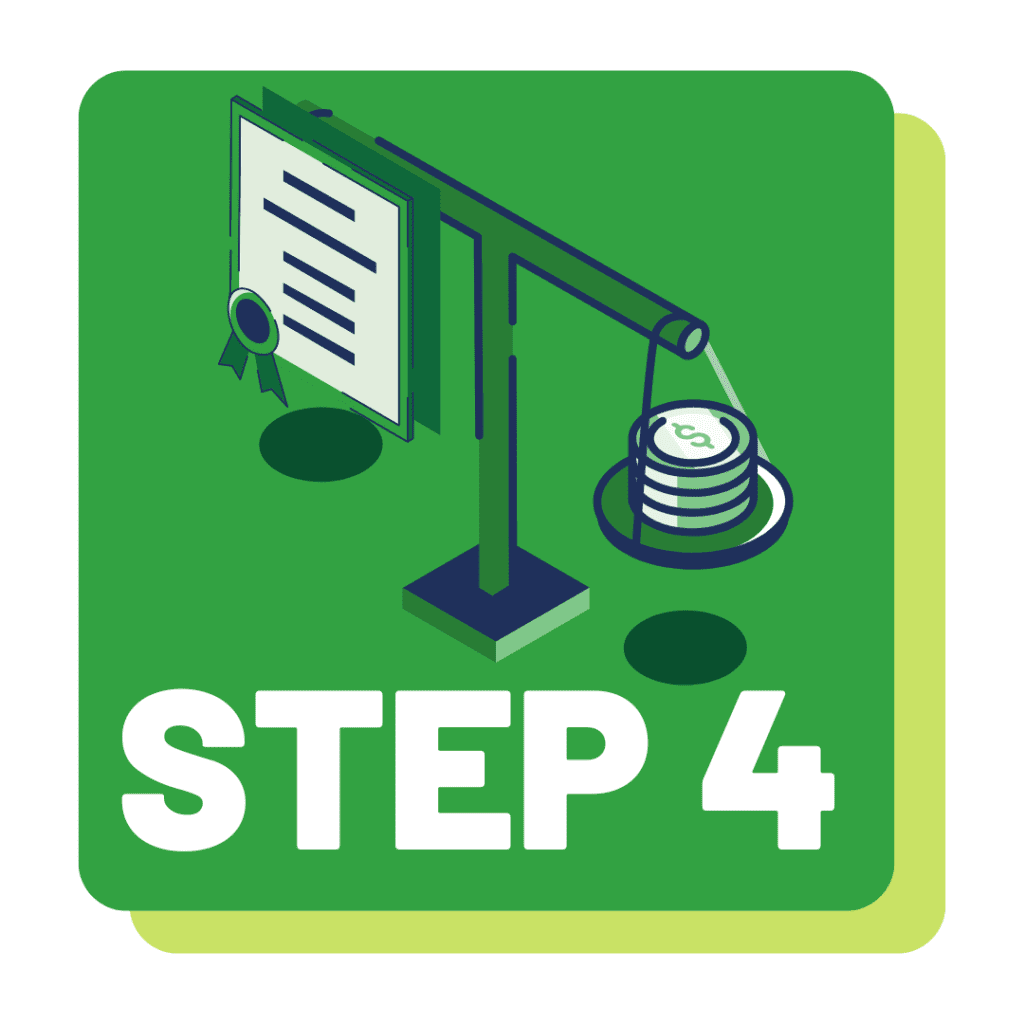Unlocking federal and state student aid to make college more affordable takes four easy steps:
- Create your StudentAid.gov Account
- Complete the FAFSA
- Apply for State Aid
- Evaluate and Compare Financial Aid Award Letters
Scroll down for more guidance and resources pertaining to each step. And if you live in New York, schedule a free, one-on-one virtual session with an EDCAP counselor. We can provide you with personalized assistance at each of the stages to maximize your financial aid outcomes and go to college with less debt.

Step 1: Create Your StudentAid.gov Account
Establish your StudentAid.gov account to access key resources and track your federal financial aid throughout your academic journey.
How to Create Your FSA ID
- Visit studentaid.gov and click on “Create Account.”
- Provide Personal Information:
- Email address, mailing address, and mobile phone number
- Tip: You and your parent must each have a separate email account. Avoid using a high school email account.
- Set Up Challenge Questions: Choose answers that are easy to remember and unlikely to change over time.
- Verify Your Contact Information: Enter the validation codes sent to your mobile number and email, or set up an authenticator app.
- Save Your Information: Write down your login details and backup codes in a secure place for both you and your parent.
Helpful Resources
- General topics:
- Upcoming webinars / Seminarios web en español disponibles:
- For Parents:

Step 2: Complete the FAFSA
Submit the FAFSA as early as possible to determine your eligibility for federal grants, loans, and work-study programs. Doing so can open up more funding opportunities, so don’t wait—take this step today to make your education more affordable!
Completing the FAFSA is a key step toward financing your education. By submitting this form, you’ll unlock access to various federal financial aid options, including grants, loans, and work-study programs, as well as additional state and school-based aid opportunities.
Why Complete the FAFSA?
The FAFSA determines your eligibility for federal financial aid, which can significantly reduce your college expenses. Many scholarships, state aid programs, and institutions also rely on your FAFSA results when deciding on additional aid.
When to Submit the FAFSA?
To maximize your financial aid, submit your FAFSA as early as possible. The application will open December 1st for the 2025-26 academic year, and some forms of aid are limited and awarded on a first-come, first-served basis. Be mindful of both federal and state deadlines to ensure you qualify for the maximum amount available.
How to Get Started
- Create an FSA ID: Visit fsaid.ed.gov to create an FSA ID for secure access to your application.
- Complete the FAFSA Online: Go to fafsa.gov to fill out and submit your FAFSA.
After You Submit
Once you’ve submitted the FAFSA, you’ll receive your Student Aid Report (SAR) and your Student Aid Index (SAI) number, which your college or university’s financial aid office uses to determine your eligibility for financial aid. Review your SAR carefully to ensure all information is accurate, as schools rely on this report to calculate your aid package. Make any necessary corrections, and watch for updates from the schools you’re considering.
Helpful Resources
There are many guides from trusted sources. Here are a few you can explore:

Step 3: Apply for State Aid
Research and apply for any state-specific financial aid programs, including grants, scholarships, and loans, to maximize your funding options.
In addition to federal aid, many states offer financial assistance to help students cover educational costs. By applying for state-specific grants, scholarships, and loans, you can maximize your funding options and potentially reduce the need for other forms of borrowing.
Why apply for State Aid?
State aid programs are often designed to support local students in reaching their educational goals, making them a valuable resource. Many states prioritize funding for residents attending in-state schools, and some programs may cover a significant portion of tuition or other college costs.
How to Apply
Research State Programs: Visit your state’s higher education website to explore available financial aid programs, eligibility requirements, and application deadlines. Each state’s offerings vary and can include grants, merit- or need-based scholarships, and low-interest loans.
Meet Deadlines: State aid deadlines are often earlier than federal deadlines, so it’s crucial to apply on time. Some states operate on a first-come, first-served basis, so the sooner you apply, the better your chances of receiving aid.
Complete Additional Applications: Some state programs may require a separate application beyond the FAFSA, such as a state aid application or specific scholarship forms. Carefully follow the application instructions to ensure you submit all necessary documents.
After You Apply
Once you apply, keep an eye out for any communication from your state’s financial aid office or your chosen schools regarding your state aid status. Some aid packages may be awarded in combination with federal and institutional aid, which could increase your overall support and reduce the need for loans.
State aid is an important part of funding your education. Take the time to explore these resources and apply early to make the most of your financial aid opportunities!
New York State Aid
New York State offers several financial aid programs designed to make college more affordable for residents. Key programs include:
- Tuition Assistance Program (TAP): Provides grants to eligible New York residents attending in-state colleges, based on financial need. TAP awards can cover a portion of tuition costs, helping to reduce out-of-pocket expenses. To see which schools accept TAP, visit HESC’s TAP School Codes webpage.
- Excelsior Scholarship: This program enables eligible students to attend SUNY and CUNY schools tuition-free. Applicants must meet specific residency and income requirements and commit to living in New York after graduation.
- Enhanced Tuition Awards (ETA): For students attending private colleges in New York, ETAs provide up to $6,000 in financial assistance, combining state awards with contributions from participating institutions.
- Other Programs: New York also offers additional support for part-time students, military veterans, and specific fields of study, including STEM and teaching.
To apply for New York State aid, complete the FAFSA and then submit the New York State Aid Application through the Higher Education Services Corporation (HESC) website at hesc.ny.gov.
New York State Aid for Undocumented Students
The New York State DREAM Act grants access to state financial aid for undocumented students and others previously ineligible due to immigration status. Eligible students can apply for key programs, including:
- Tuition Assistance Program (TAP): Grants to help cover tuition.
- Excelsior Scholarship: Tuition-free education at SUNY and CUNY schools.
- Enhanced Tuition Awards (ETA): Financial aid for students attending private New York colleges.
- Other State Scholarships and Grants: Additional awards based on specific criteria, such as career path and academic achievements.
Eligibility Requirements
Students generally qualify if they:
- Graduated from a New York high school or earned a state equivalency diploma.
- Have lived in New York State for at least one year prior to applying.
- Are ineligible for federal financial aid due to immigration status.
How to Apply
Apply through the NYS DREAM Act application on the HESC website. The process is secure and confidential, and HESC offers resources to guide you.
The NYS DREAM Act makes higher education more accessible to all New Yorkers—explore your options today!
Helpful Resources
- EDCAP’s Scholarship Guide
- NYS Grants & Scholarships – Higher Education Services Corp. (HESC)
- How to Apply for TAP and Other NYS Student Financial Aid (English)
- How to Apply For TAP and Other NYS Student Financial Aid (Spanish & Other Languages)
- Excelsior Scholarship
- NYS Dream Act for Undocumented Students – HESC

Step 4: Evaluate and Compare Your Award Letters
Once you receive financial aid offers from schools, carefully compare the award letters to understand the mix of loans, grants, scholarships, and out-of-pocket costs before making a final decision.
When you receive financial aid offers, review each award letter to understand the breakdown of loans, grants, scholarships, and any out-of-pocket costs. Comparing these details helps you make an informed decision by identifying which schools provide the best financial fit for your needs.
Key Considerations
- Total Aid vs. Costs: Review the amount of aid versus tuition and fees.
- Grants & Scholarships: Look for “free money” that doesn’t need to be repaid.
- Loan Types & Amounts: Note loan types and repayment terms.
By carefully evaluating each offer, you can choose the best financial path for your education.











